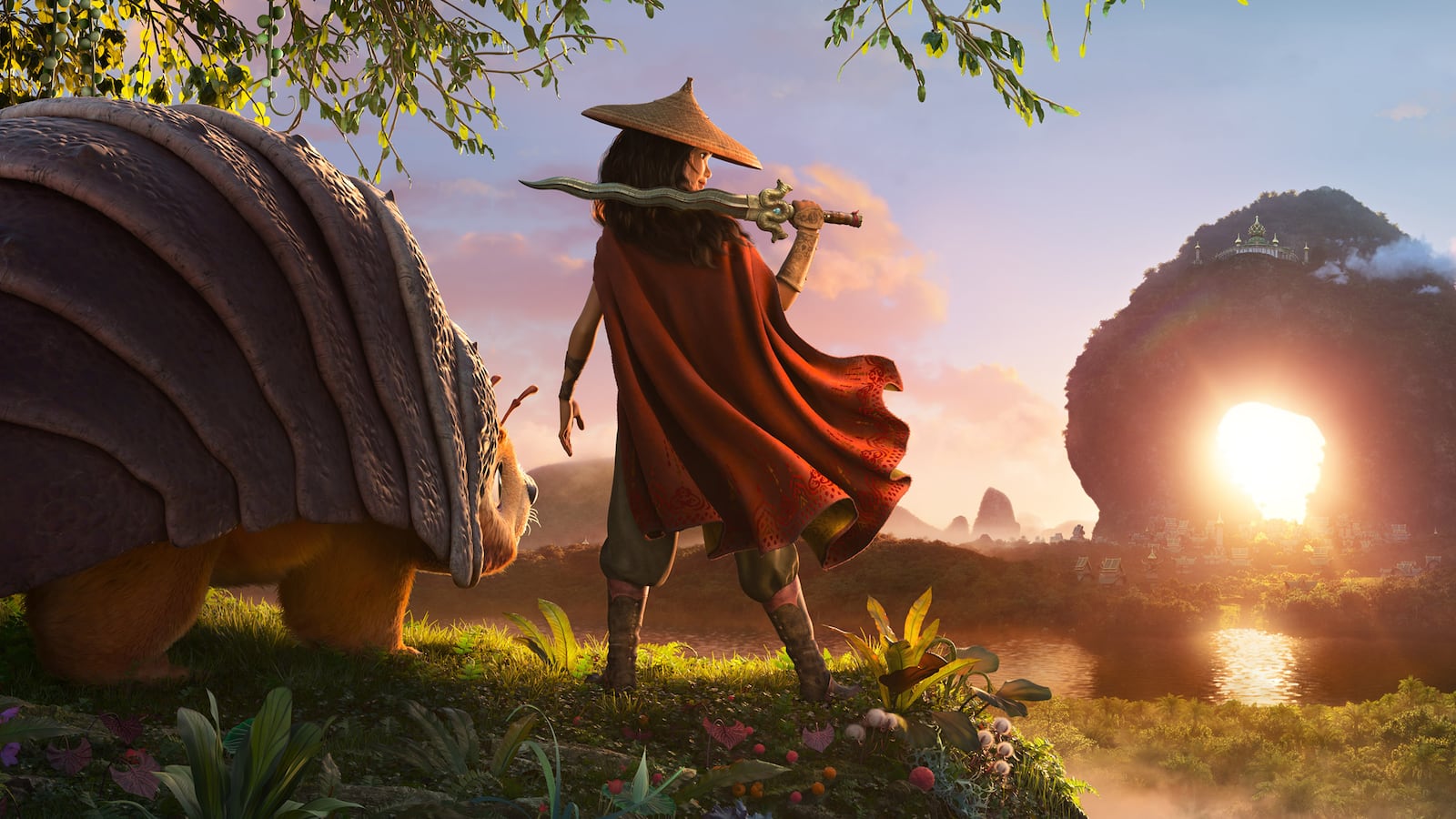Disney does not deserve Kelly Marie Tran.
In 2017, the Vietnamese American actress became the first woman of color to co-lead a Star Wars movie, playing the resourceful rebel mechanic Rose Tico in director Rian Johnson’s Star Wars: Episode VIII — The Last Jedi. It was her first major screen credit after years spent in bit parts and on improv stages, rocketing her from obscurity to worldwide blockbuster recognition.
The once-in-a-lifetime experience came with daunting responsibility; to be the “first,” one person tasked with representing many, is an important but sometimes lonely position. Still, Tran met her task with wide-eyed enthusiasm. Rather than play it cool during the press tour leading up to the film’s release, she was a beaming, excited presence. Her director told stories about her shadowing other departments on set, eager to absorb the experience from every angle. And onscreen, it was Tran’s sincerity and guileless warmth—and not just the features of her face—that marked Rose as a new kind of Star Wars character. It felt natural that she delivered the film’s thesis herself, redefining heroism for the new saga: no longer “fighting what we hate, but saving what we love.”
Tran was “too pure for this world,” as besotted fans often noted at the time. Still, as the actress herself recalls in a Hollywood Reporter cover story published this week, that open-heartedness also seemed to make her a target. Reactionaries took aim at her online for everything from her character’s choices to her race to her weight. Tran disappeared from social media to protect herself, but their words inflicted pain. In a New York Times op-ed, she later reflected on blaming herself for the vitriol: “I thought, ‘Oh, maybe if I was thinner’ or ‘Maybe if I grow out my hair’ and, worst of all, ‘Maybe if I wasn’t Asian.’” She wrote that the ordeal hardened her resolve to tell stories that reflect the diversity of human experiences, so that episodes like hers might become less common.
When she reemerged on her next Hollywood red carpet—for 2019’s The Rise of Skywalker, in which Rose Tico barely appeared at all, inexplicably—Tran debuted a markedly different presence. Less bubbly and overwhelmed than glamorous and poised. In form-fitting blue sequins, she looked untouchable. Statuesque. Almost defiant. And then she’d burst into full-throated laughter.
It’s difficult not to recall Tran’s journey through Hollywood while watching her newest film, Disney’s animated fantasy Raya and the Last Dragon. It’s her first leading role since the Star Wars films, and exactly the kind of story Tran resolved to help tell. Not only inspired by a number of Southeast Asian cultures and voiced by an all-Asian cast, it spotlights the diversity of the cultures it draws from with a range of skin tones, facial features, styles of dress, weapons, even traditional food dishes. (A warning: It’s got the most mouthwatering animated food this side of a Hayao Miyazaki film. Do not go into this movie hungry.)
But more than that, the story of Tran’s heroine Raya resonates with the actress’ own in perhaps unexpected ways. It’s a cautionary tale in part about the harm of hardening oneself with anger or mistrust as a means of self-preservation—even after trauma. Over the course of the movie, Raya must learn to connect with others again, at the risk that they might abandon, hurt, or disappoint her. Tran’s return to the spotlight—to press interviews, the pressures of representation, and to Disney, no less, after the studio failed to meaningfully support her in any way amid the online attacks and allowed her groundbreaking Star Wars character to be all but written out—implies a similar sort of grace.
It is also a story about emotional and spiritual rebirth. Tran has experienced one of her own. Three years after disappearing from public view, she has risen to claim the title of Disney princess. But as Raya and the Last Dragon shows, it’s really Disney that’s lucky to have her more than vice versa.
Directed by Don Hall and Carlos López Estrada, Raya and the Last Dragon is an action-heist movie, starring a strong, plucky heroine cut from familiar Disney cloth. In an early prologue, a young Raya announces herself with acrobatic leaps of weapon-wielding skill (and a painfully cute animal sidekick), navigating through booby traps straight to the heart of an ancient temple. She is part Indiana Jones, part don’t-need-no-man Disney princess of the post-Frozen age. And while Disney’s animation teams have outdone themselves here—Raya is the most visually beautiful film of the studio’s CG-dominated animation era—it is Tran’s voice work that first brings the movie to life.
Raya’s world is meant to evoke parallels to our own. It is deeply fractured by cultural divides that seem unbridgeable, sometimes for reasons like hurt from past betrayals and sometimes out of baseless prejudice. The hatred between these groups has allowed mindless, malevolent forces called the Druun (“a plague born from human discord”) to ravage the earth, turning it into a post-apocalyptic wasteland. More frighteningly, direct contact with a Druun instantly hardens humans into statues. It’s not a difficult metaphor but arresting onscreen nonetheless: Anger and resentment literally turn people to stone.
A group of dragons, we learn, once saved this world from the Druun by sacrificing themselves and concentrating their magic into an orb that repelled them. 500 years later, Raya and her father Benja (voiced by Daniel Dae Kim) are tasked with guarding the orb in their home capital, in one of the five splintered nations that once made up a land called Kumandra. Benja is a stubborn idealist, confident that the nations can set aside their differences if only they all get to know one another over a nice hot stew.
Following his example, a young Raya befriends a cool-looking girl from a rival nation. Possibly bamboozled by her new friend’s asymmetrical undercut, Raya shows the girl the dragon stone’s secret hiding place—and is shocked when Namaari (Gemma Chan) betrays her and tries to steal it. The chaotic free-for-all that follows among the people of all five nations ends with the sacred stone itself now broken into five pieces, too, allowing the Druun to attack and turn thousands of people, including Raya’s father, to stone. Six years later, wracked with survivor’s remorse, a far less trusting Raya sets out to collect the stone pieces, drive away the Druun, and somehow, hopefully, summon the last surviving dragon to free her poor dad.
Blessedly, the plot (as scripted by Qui Nguyen and Adele Lim) is never as unwieldy as it looks on paper. That’s in part due to the ever-changing texture and feel of the movie as Raya sojourns from one nation to the next, staging shard-stealing heists. And in part it’s a credit to the movie’s cast. With each pit stop it expands, creating a found family of weirdos as inspired as Con Baby, an actual baby con artist (voiced by Thalia Tran), and the dragon Sisu, brought to life with rambling earnestness by Awkwafina. Their world of chimeric creatures like Tuk Tuk—half-hedgehog, half-armadillo, for some reason the size of a rhinoceros—is as wonderfully strange as that of Avatar: The Last Airbender. And though her role as the straight woman in a crew of loons could have rendered Raya bland by comparison, Tran ensures she is instead a beacon of emotional relatability.

Kelly Marie Tran arrives for the world premiere of Star Wars: The Rise of Skywalker on December 16, 2019, in Hollywood, California.
Alberto E. Rodriguez/GettyThe characters are astonishingly expressive, miming voice actors’ micro-expressions to a sometimes stunning degree. In Raya’s case, Tran’s warmth and vulnerability are as vivid onscreen as the colorful world she inhabits. The most expressive actors can sometimes run into difficulty channeling a nuanced range of emotions through their voice alone, but Tran does it effortlessly. Her Raya is childlike and unburdened at the start of the film; swashbuckling if wary and faintly sad through her time alone; centered and wise enough to inspire a leap of faith by movie’s end.
She emphasizes Raya’s struggle throughout with the assured hand of someone who can deeply relate. You hear it in her voice: The part of her that wants to believe in people again and the part that insists she knows better. Indeed, it was Tran who engineered one of the film’s most moving examples. When Raya first recites the incantation that summons Sisu, as Tran recalled to THR, it was her idea to rewrite the dialogue to underscore Raya’s reluctance to reach out and trust again.
The movie unfolds its plot gently, without denying the selfish realities of human nature. When a character has the opportunity to lie, cheat, or recoil in mistrust, more often than not, they do. Does all of it get suddenly tied up in a neat, Mickey Mouse-patterned bow by movie’s end? Of course. People’s better instincts triumph over evil, we all learn to live in harmony, everyone smiles and dragons prance. Still, there is something to be said for the way it gets there.
Unlike in so many modern action stories, saving the world in Raya and the Last Dragon does not mean subduing the hero’s archenemy—it is not Raya’s strength in combat or her wit that turns the tide of her lifelong battle with Namaari for control of the stones. Instead, Raya’s final act of heroism is an act of total surrender. It is sacrifice and forgiveness, defying every instinct she’s cultivated for self-preservation.
The movie posits Raya as an example for our bitterly polarized world: Someone willing to open their heart to human connection again, refusing to turn to stone in the face of human cruelty. A better one might be Tran herself.


